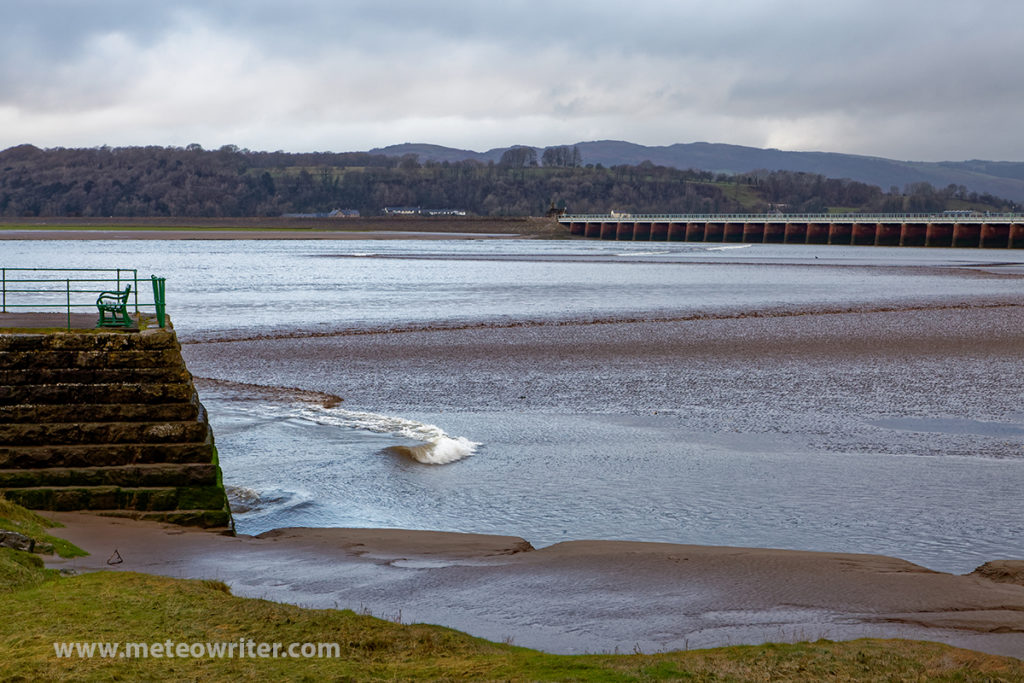On the highest tides, a most unusual sight can be seen in the Kent Estuary in Morecambe Bay called the Arnside Bore. This is one of about twenty tidal bores that occurs in the UK and is named after the village of Arnside. It is quite a spectacle and often draws crowds of onlookers.
The source of the Kent is the Kentmere Valley near Ambleside and the river then flows down through Kendal to Morecambe Bay. Arnside is on the southeastern side of the estuary and is a pleasant place to wander with a good choice of shops, pubs and cafes. Along with scenic views of the distant Lake District fells, there is a much-photographed railway viaduct that carries the coastal railway. The tree-covered slopes of nearby Arnside Knott are a good place for views of the estuary, including a plaque showing the names of hills in the distance.
One feature of the estuary is its high tidal range and many people have been caught out by the tides over the years. Signs on the promenade warn about the dangers of fast rising tides, quicksand and hidden channels. Due to the risks, during daylight hours in the tourist season the council sounds a warning siren twice as the tide advances.
When conditions are right, the siren also serves as an indication that the Arnside Bore is approaching from Morecambe Bay. The first blast typically occurs about 15-20 minutes before the wave arrives and the second as it passes New Barns Bay near Blackstone Point.
The speed and power of the wave can be most impressive to see. Usually it dissipates on reaching the viaduct but sometimes it travels further inland to Sandside and the mouth of the River Bela. However, it is smaller and less predictable here. There have also been occasional sightings from the opposite shores near Grange-over-Sands.
As with any natural phenomenon, sightings are not guaranteed and only occur under certain conditions. Factors that can affect the wave’s passage include onshore winds, low pressure in the Irish Sea and high flows in the River Kent.
Water levels rise quickly once the wave passes so it is important to keep off the sands and mudflats. The car park near the railway viaduct is prone to flooding and in extreme tides part of the road between Arnside and Milnthorpe floods too. The RNLI website has some excellent advice on water safety.
If you are interested to learn more about tidal bores, I’ve now included them in three books:
The first, called Spectacular Britain, published by Bloomsbury in 2024, is described on this webpage and gives tips for non experts on spotting more than twenty of the UK’s space, tidal, weather and wildlife phenomena, including an introduction to some of the most popular tidal bores.
The next, called The Cumbria and Lake District Coast, is about places to visit, the history and wildlife of the coastline from Morecambe Bay to the Solway Firth, from Fleetwood to the Mull of Galloway. It is described on this webpage.
The Cumbria and Lake District Coast
In addition to the Arnside Bore, it includes brief descriptions and photographs of the Lune, Leven, Duddon, Solway and Nith tidal bores.
A Coast Magazine Book of the Month
For a more in-depth look at the tidal bores of England, Scotland and Wales, the following book features ten tidal bores, including the Arnside Bore.
Tidal Bores of England, Scotland and Wales
Along with a discussion of why tidal bores occur, it gives tips on how to find out tide times and improve your chances of seeing one.
There are also brief summaries giving ideas for places to visit nearby around the surrounding coast and estuaries, including tourist attractions and nature reserves. It is available as an ebook from Amazon, Google Play, Apple and Kobo and this webpage gives more details.
Note: this post is an updated version of an article first published in February 2020

